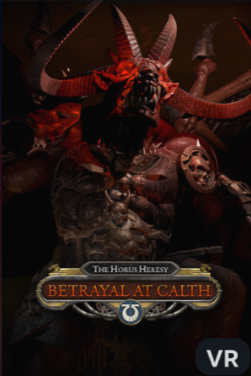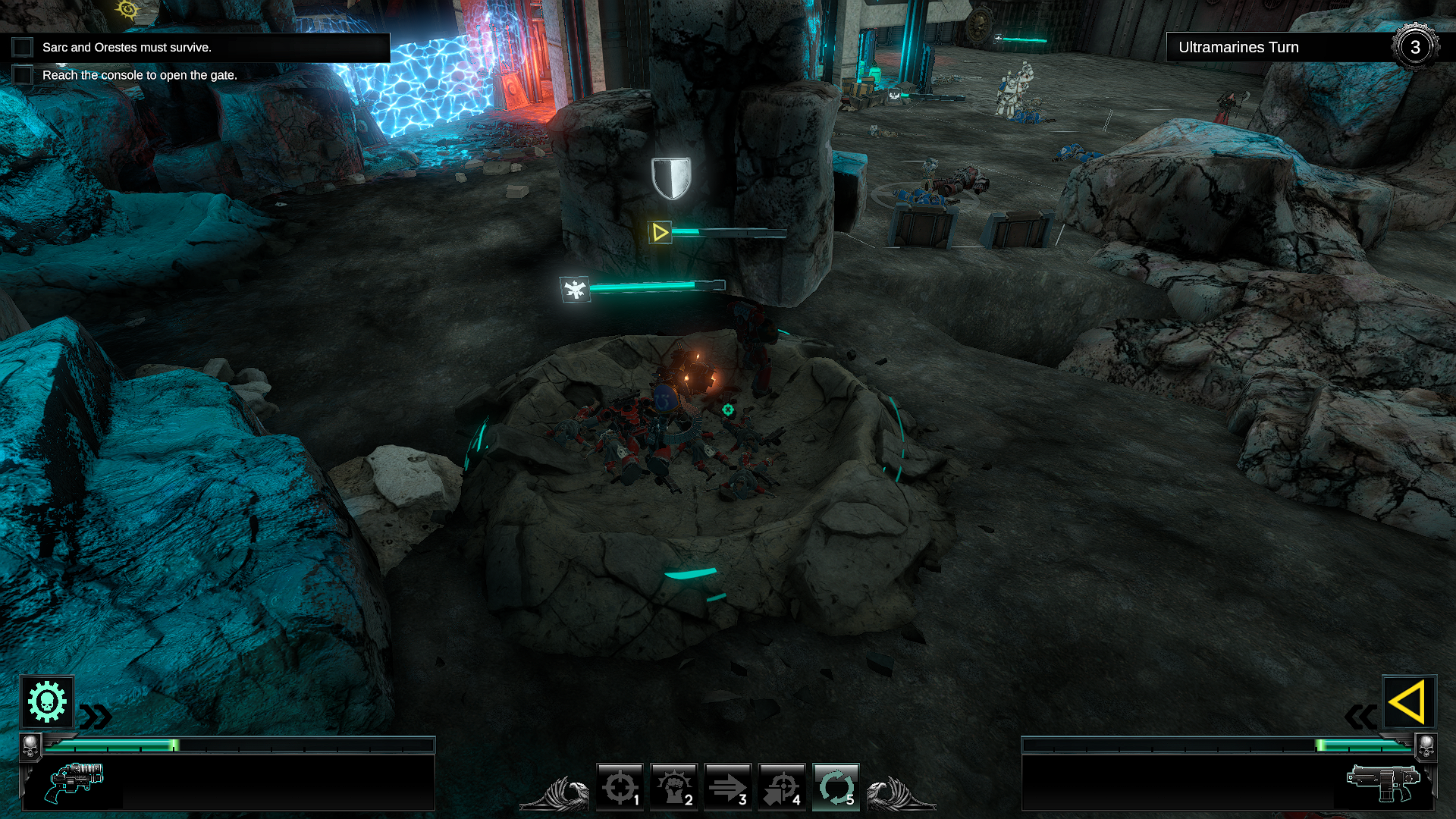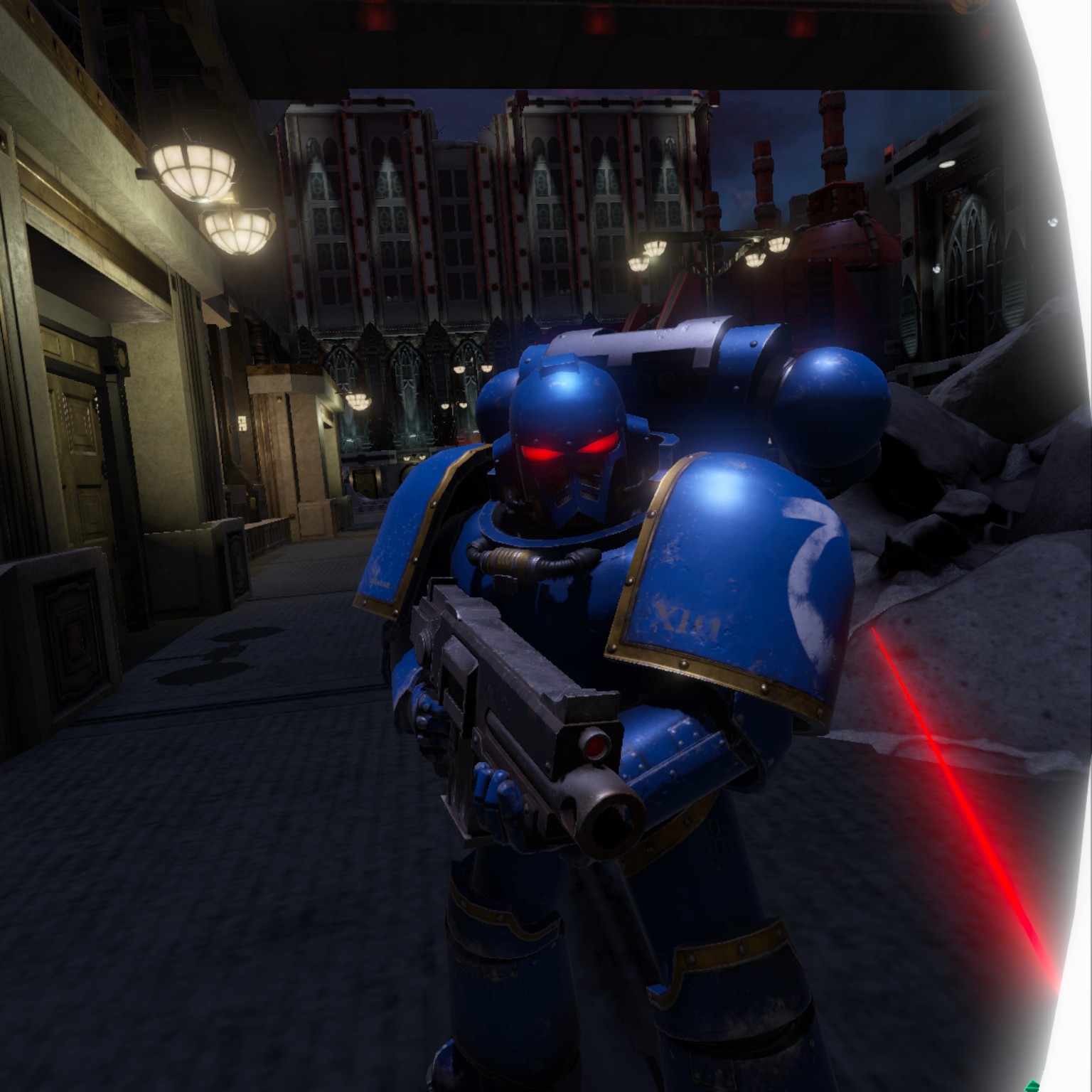Search
[{{{type}}}] {{{reason}}}
{{/data.error.root_cause}}{{{_source.title}}} {{#_source.showPrice}} {{{_source.displayPrice}}} {{/_source.showPrice}}
{{#_source.showLink}} {{/_source.showLink}} {{#_source.showDate}}{{{_source.displayDate}}}
{{/_source.showDate}}{{{_source.description}}}
{{#_source.additionalInfo}}{{#_source.additionalFields}} {{#title}} {{{label}}}: {{{title}}} {{/title}} {{/_source.additionalFields}}
{{/_source.additionalInfo}}- Details
- Category: Virtual Reality
- By Dana Schwanke
- Hits: 910
The Horus Heresy: Betrayal At Calth (Oculus Rift)

The Horus Heresy: Betrayal At Calth
Developed By: Steel Wool Studios
Published By: Steel Wool Studios
Released: May 28, 2020
Available On: Microsoft Windows
Genre: Turn-based strategy
ESRB Rating: None Available
Number of Players: Single-player campaign, Online Multiplayer
Price: No longer available
Thank you Steel Wool Studios for sending us a copy of this game!
The Horus Heresy: Betrayal at Calth is a turn-based strategy game set within the Warhammer 40,000 universe, probably better known as Warhammer 40K. You take control of a tech wizard and a faction of Space Marines called the Ultramarines on planet Calth during a cataclysmic event in which a Space Marine faction known as the Word Bearers turn against their brothers in arms, the Ultramarines, and attempt to take control of Calth for themselves. Battle your way through a series of levels pitting your marines against theirs and take the planet back in the name of the Emperor.
At CCG, we typically talk about gameplay first and then get to the game's weak points and then its morality. However, for the sake of those who are unaware of the Warhammer 40K universe or its setting, I feel it deserves some explaining, which will lead directly into the moral issues, the problems with the game, and end on the actual gameplay itself. Before I get into that, there are two glaring issues that needs to be discussed. Firstly, you can't actually purchase the game anymore. The game appears to have been abandoned in development for unknown reasons. Steel Wool Studios was working on the Betrayal at Calth at least as far back as 2017, considering they had taken part in a Reddit AMA that year for it. Even the game's official website has since been bought and is now an Indonesian sports website if my browser's translation function is to be believed. In other words, the game was left unfinished, and it shows. Second, the number of bugs and crashes I encountered increased the further into the game I played, to the point where I could not finish it. I believe I've played about 75% of the campaign and can talk about it here. Just be aware that should someone somehow get their hands on this AND manage to succeed in getting into the final Act of the campaign, I cannot vouch for what is or isn't there. Specifically, I didn't see any in-game demonic references, but considering the image for Betrayal at Calth in Steam's Big Picture Mode looks like this, it is at least a possibility there is some later.
Warhammer 40K is a series that is widely known in tabletop gaming circles. Interestingly, the video game The Horus Heresy: Betrayal At Calth is based on a board game of the same name as opposed to being a direct offshoot of the overall Warhammer 40K ruleset. While I have not played either of the tabletop games myself, I have talked to many players over the years and have read a few of the novels.
The moral quandaries make an appearance in The Horus Heresy: Betrayal at Calth include zealotry towards the Emperor as supreme ruler, the skulls of humans being used as "drones" under the control of the player, the inclusion of a tech magus as a playable unit, and killing (albeit with no blood shown). In other words, this particular installment isn't awash in the worst of all that the Warhammer 40K setting has to offer, but a wider understanding of the story this is a part of may be important if you are trying to make a decision as to whether or not this is something you would like to get into in general. For the sake of the uninitiated, suffice it to say this: Warhammer 40K is set in the far flung future where humanity has long mastered space travel and populated planets all across the universe...and what they found out there constantly seeks to end them and take control of everything under its own banners. The word used by the community is "grimdark": Everything is bad, everything is trying to kill you, and terrible things are often done in the name of survival. Much of this world's technology comes at the cost of unimaginable pain and suffering on the part of the humans required to run it. For example, some humans have psychic abilities; these are called psykers. These humans are then taken, have wires and probes surgically installed into their skulls, and are used as on-board navigators and long-distance communicators for planets and ships, allowing instant transmission across the galaxy, but at the constant risk of overload or psychic attack, causing them to die agonizingly.

Strong Points: Cool to see Space Marines in VR
Weak Points: Clunky camera; half-explained combat system; repetitive music and voice lines; boring campaign
Moral Warnings: False god religion; bloodless violence, robots made from human skulls; demonic cover art
In this far flung future, humanity has a single Emperor who is kept in near-death stasis for millennia and is believed by mankind to be God. They believe it is his will that they are to follow and his will that they should subjugate the universe under human rule. They believe it is his guidance that allows them to travel safely through the Warp, the subspace which enables interstellar travel and which is also home to demons which corrupt and possess humans. Humans believe all aliens ("xenos") are inherently evil (and many are) and must be purged. And humans believe that being open to any other way of thinking is a weakness that allows other corrupting influences to invade your mind. In other words, many aspects of Christianity are taken and twisted, with a false deity at the top, demons a constant existential threat, and a push for people to be completely close-minded lest they be led astray.
An oddity of the setting is that, at some point before the time when Warhammer 40K itself is set yet still far into the future, some cataclysm happens which causes humanity to lose knowledge of much of the workings of much of this future technology, to the point where science and religion are much the same in universe; the planet Mars, for instance, is run by "tech priests" whose job it is to look after important machines, learn how they work, and provide humanity with what useful things they can. Soldiers are known to recite things like the "Litany of True Striking" before firing their shoulder-mounted artillery ("Sweet Emperor, guide this missile into the heart of your foes.") or the "Litany of Unjamming" when their gun jams ("Spirits of the Machine-God, aid your servant and free his weapon so he may use it to break his foes.").
The irony of the situation is that I clearly didn't know the proper litany to deal with the myriad technical issues I had just trying to play Betrayal at Calth, and since it's no longer available to buy, there weren't any tech priests online who could help me. The game is playable in either PC or VR mode; when it is launched via Steam, a pop up will ask the player which they want to play it in. However, no matter what I chose, it always popped up in VR mode. I know I could have mitigated this by disconnecting my entire VR set from the computer, but that's a lot of work for what I figured should be a quick fix. After ditching my glasses for a pair of contacts, I went to actually start playing...except I couldn't click on anything. Turns out, if you don't have the PC's active window set to the mirror view of what is being seen in the headset, you can't actually click anything while using the VR, even though your hands move and the laser pointer points around inside the headset. Once I finally figured that out, I found out that there is a button on the main screen of the game that you can press to switch to PC mode. So every time I went to play, I had to launch into VR, don the headset, click the PC button, doff the headset, and could then play in PC mode. All of that coupled with several non-bug tech issues involving my VR controllers and keyboard led the first couple sessions I had with Betrayal at Calth to be a combination of surreal and annoying.
Since I'd already gone through the effort of getting the VR set up, I decided to use it for my first full session. Credit where credit is due, that first time being up close in front of a hulking Space Marine is pretty epic. Once the game starts in earnest, though, there's little reason to play in VR. The controls share those of many other VR titles: pull a trigger and point to move. You can also change the camera height to view more of the battlefield, but it caps out far below the height I'd call a proper bird's eye view. You can flip open a 2D rendering of the entire battlefield at any time, but I always found the representation more confusing than useful. What is handy is that clicking anywhere on the minimap will teleport the camera to that spot, which makes the task of fighting a battle across a large map easier. On the flip side, if you want to just WASD your camera around, it'll get stuck on walls and terrain constantly. In certain underground levels, the mere act of moving your camera is a frustrating chore. In that end of that same underground level, the game crashed a least 3 times, forcing me to start it all over each time. Issues exist in VR mode as well, with your hands freezing midair sometimes as you point around the map, leaving you unable to take any actions for several seconds at a time and usually crashing the game a few minutes later. The straw that broke the camel's back and made me permanently put the game down nearly 3/4 of the way through was in a level where I had to restart the level multiple times due to it being a significant ramp in difficulty level, only to have the game glitch itself into a soft-locked state on my last two attempts: once because an enemy never started his attack animation, preventing the game from proceeding to the next turn, and once because one of my units inexplicably merged with an enemy unit, making the unit unselectable and keeping me from being able to move to the next round.

Higher is better
(10/10 is perfect)
Game Score - 32%
Gameplay - 6/20
Graphics - 4/10
Sound - 2/10
Stability - 1/5
Controls - 2/5
Morality Score - 70%
Violence - 5/10
Language - 10/10
Sexual Content - 10/10
Occult/Supernatural - 0/10
Cultural/Moral/Ethical - 10/10
Then there is the gameplay itself. As stated before, Betrayal at Calth is a turn-based strategy game. Each round starts with the player, who chooses one of their units, can choose one of 5 actions for them to perform (shoot, assault, move, advance, or pass), and then it is the enemy's turn to do the same. Each unit can take two actions per round. Once every unit on the battlefield has expended their two turns, play moves to the next round, once again starting with the player. This is a solid basis for a combat system; the player's choices become not just a matter of how best to use each unit, but balancing both offense and defense each turn. Every turn where you go on the offensive with one unit is a turn you may have left another unit vulnerable. Every turn you spend moving a unit into position is one where the enemy has time to weaken another.
The core of the combat is really solid. The way it is executed is not, however. For starters, units move fairly slowly across the map, take a while to finish their actions, and then there is a second-long transition between the player's turn and the enemy's turn and vice versa. It'd be just a minor grievance if not for the fact that, many times, the enemy has more units than the player, and so the player will spend a couple minutes at the end of the first round or two waiting as the enemy AI slogs through another 2 turns per extra unit they control while you just wait. Then there are 5 actions each unit can take. If you just launch into the game and start the campaign without paying attention, though, the game does nothing to explain what the actions actually do. I got through the entire first act of the game before I even realized when loading into my second session that there was a tutorial. But even the tutorial leaves so much unexplained. It will tell you what each action does, and certain levels during the main campaign will give mini tutorials about things like terrain or armor. But I played through over half the game before discovering that some specialized units have multiple different attacks you can choose from. I only found it out because I opened the controls menu on a whim and noticed an option I'd never seen before. On top of this, some attacks have special abilities tied to them, like, "Has a 50% chance to steal 2 technical points." What are technical points? I have no idea. It's a term I haven't found at any other point while playing.
Unexplained mechanics don't stop there, either. I found out, again by accident and again over halfway through the game, that you can combine units with identical types. See, most units are actually multiples: 2 or 3 Space Marines, or maybe 4 or 5 infantrymen, and as that unit takes damage, individuals within the unit die. Does this make that unit do less damage? I'm not sure; it's not explained. But you can combine a unit with 3 infantrymen into a unit with 4 infantrymen to make a single unit of 7. Does this make them stronger? Increase defense? Just let them take up less space? Again, not explained. I also found out very early on that units cannot pass through each other, even when they're on the same team. How did I find out? Well, one level has you evacuating an area where every round more and more tiles become covered with flames which instantly kill any units still standing there when the next round begins. There is one tile in a corner of the map down a short "alley" which is the evacuation point. I mopped up the enemies on the map fairly quickly and moved my units toward the exit. Only after I had gotten all of my units near the exit and the flames were directly cutting off any way back out did I realize, by moving one of my basic units onto the evac space, that the game only wanted two of the special units to step on that space. Any other unit who stepped there just stayed there until moved. Except I had positioned my units such that there was no way for them to back out of the hallway: the was fire on one side and the rest of my units on the other, no way for the units to go around each other, and no way for them to pass through each other. Despite it being such an easy level, I lost because the fire overtook everyone before my special unit could land on the evac space.
Beyond all the technical and moral issues, the part of a game that is least important in my opinion is the graphics and sound design. Having a consistent and engaging graphical style is more important than having the most fidelity or lighting, and that first impression of being in VR and seeing the floating skull drones and the Space Marines inches from my face was incredibly fun. Once that initial coolness factor was over, though, I was looking at characters who would phase through the floor when halfway up a set of stairs, or flying units embedded in the ceiling. Units would fire "towards" each other; the rockets were especially egregious, since you'd see a unit fire one off, it would clearly smack into a nearby wall and explode, and then the target multiple tiles away would fall over dead. The "dreadnaught" units with their chain guns would visually fire towards a space several tiles to the side of their intended targets as well.
If the graphical quirks weren't immersion breaking enough, the sound design put the final nail in the coffin. Every level I played used the exact same boring music track. The track is maybe a minute or so long and is the kind of music you'd expect to hear in the lobby waiting to join into a multiplayer match of some online FPS game. And every time you or an enemy unit moves, the unit will call out one or more voice lines, depending on how many individual people comprise that single unit. For the first half of Betrayal At Calth, you'll be playing as one faction of Space Marines against another and will be forced to listen to, "For the Emperor!" or one of maybe 3 lines recorded for each unit type overlapping as multiple characters shout one out every single time someone makes a move.
The only thing I haven't mentioned so far is the online multiplayer. The player has the option to play matches either with friends in a private lobby or let the game perform online matchmaking. You start by building an army for either the player or enemy faction from the main campaign, where you are given a set number of points and each unit type costs some number of points. Then, you ready up. The screen that pops up when starting multiplayer is nice enough to tell you how many players are currently online: 0. The "Stop" button on the "Searching for matches" screen doesn't actually do anything, so I was expecting to have to Alt+F4 my way out. It turns out, the back button, partially obscured behind the splash screen, still works and will take you back to the previous page.
All in all, The Horus Heresy: Betrayal at Calth is a mess of poor design decisions, unexplained mechanics, and bugs. Even clicking the "Credits" button on the main screen launches the credits only for the scrolling text to freeze for 20 seconds before unfreezing after most of the credits have already "scrolled" by. The saddest part is seeing that there is a nugget of goodness in here that, with some time and polish, could have been turned into a respectable game. With some downgraded graphics, fixes to the problems mentioned, and an expanded story, I could see this as being a compelling mobile game. As it is, though, for those who didn't manage to get your hands on it before it was taken off Steam, you're not missing much.
-maestro_dana








